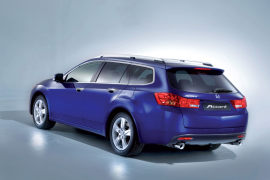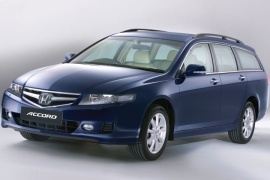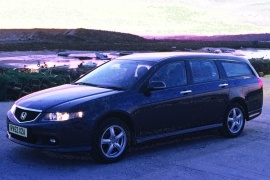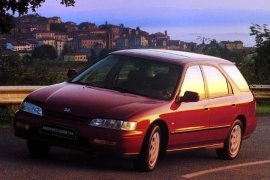HONDA Accord Tourer Models/Series Timeline, Specifications & Photos
First production year: 1993
Engines: Diesel, Gasoline
Body style: Wagon (station wagon, estate, combi, touring)
The eighth generation of the Accord Tourer (station-wagon) was unveiled at the Geneva Motor Show. Its sedan sibling was already on the market for a few years.
It was the last generation officially sold on European soil. While its predecessors were nimble and fast, the eighth generation of the Accord Tourer was built for comfort. But unlike its predecessor, the design team took a long time to draw it and it was a more pleasant view.
From the outside, up to the B-pillar, it was the same vehicle as to the sedan. From there on, the body was different. It featured a longer roof and different rear doors. Behind the last row, there was another side window. The back with the tailgate was raked and tried to look more aerodynamic. A small roof-spoiler was placed on top of the rear windscreen.
Inside, there was the same interior for the front, with the large and comfortable seats. There was an extra button to power-open the tailgate when it was fitted. The rear seats offered more headroom than the sedan, but it was enough for tall passengers. The seatbacks were folding in a split 60:40 way.
The Accord had a strong engine lineup consisted of three units: two gasoline units and a diesel. All models were fitted with a standard 6-speed manual, and both gasoline units were available with a 5-speed automatic.
When Honda introduced the eighth generation of the Accord in Europe, it didn't know that it won't last for too long, so it built it right.
If it wasn't for the world financial crisis, maybe Honda could have kept the Accord and the Accord Tourer on the European market. But it couldn't. The lack of engine range and some other sophisticated features led to slow sales and, eventually, to drop out of the market just three years later.
Honda already made a European-spec Accord and tuned it for the local roads. Its look was also on par with other carmakers. Its mix o sharp angles and curved surfaces were a lesson well-learned about the new-edge design trend. Its headlights, angular and swept-back on the sides, the shield-like shape of the grille, and the sporty-looking front apron were right on the money for the European customers. On its sides, the eighth Accord Tourer finally found its proper shape, with a hatchback-style tailgate.
Its interior was vast and comfortable. It could fit five adults without any problem. In the back, the split-folding bench was there to expand the trunk from 459 liters (16.2 cu-ft) to a better 1,183 liters (41.8 cu-ft). There were compact station wagons that could do better than that.
Honda's biggest problem was with the engines. While all of them were Euro 5 compliant, there were only three of them and only one turbo-diesel unit. Moreover, even if it was an awarded engine, that turbo-diesel exceeded the 2.0-liter tax class, while Ford, Opel/Vauxhall, Renault, and Volkswagen featured under 2.0-liter engines with similar power.
The European Honda Accord received a facelifted version in 2005 along with the rest of the range and improved fuel-efficiency for specific versions.
The Accord Tourer was already famous thanks to its power-tailgate system, which was not so common back in 2005. Honda considered that it has to give some perks to the Accord's station wagon version to compensate for the exterior look, which was far from winning any design contest.
The 2006 model featured a new front fascia, with a horizontal chromed slat across its grille. Honda designers reshaped the front bumper, adding outer side air-intakes, and moved the fog-lights moved toward the center. Depending on the trim level, the Accord Tourer sported extended rocker panels and a roof-spoiler on top of the tailgate. The roof-rails were also on the options list.
Inside, the carmaker made some changes on the center stack and inside the instrument cluster. It replaced the red lettering with white and blue ones to calm down the heavy-footed drivers. Like its predecessor, it offered the car in three trim levels: elegance, comfort, and executive. The only three options available were the sunroof, navigation system, and, depending on the engine, the automatic gearbox. Its trunk was still among the best in its class. With all the seats in place, could get up to 575 liters (20.3), while with the entire split-folding rear bench folded, space increased to 1,707 liters (60.3 cu-ft)
For the facelifted version, Honda introduced a six-speed manual gearbox for the 2.0-liter gasoline and for the 2.2-liter turbo-diesel engines. That brought better fuel efficiency on the highway.
HONDA Accord Tourer 2.0L i-VTEC 5AT FWD (155 HP)
HONDA Accord Tourer 2.0L i-VTEC 5MT FWD (155 HP)
HONDA Accord Tourer 2.4 i-VTEC 5AT FWD (200 HP)
HONDA Accord Tourer 2.4L i-VTEC 5AT AWD (160 HP)
HONDA Accord Tourer 2.4L i-VTEC 5AT FWD (160 HP)
The seventh generation of the Accord was available in Europe as a sedan and station wagon, the latter being named tourer.
The Accord Tourer was introduced a year after the sedan version, and its features were unexpected in its segment. Its main problem was that it was not offered with a wide range of engines and the automatic transmission was slow.
The sharp nose design with angry-looking headlights was one of the best-designed parts of the car. Up to the B-pillar, it had the same form as the sedan version, but there was a different vehicle from there. In their quest to built a roomy interior, the Japanese designers made the tailgate almost vertical, but it was very practical since it was fitted with electric opening and closing, a feature that was uncommon for its segment.
The interior was similar to the rest of the range, with a simple dashboard design. It was offered in a few trim levels, and only the top, Executive, version was available with a sat-nav system and sunroof. The rear seat backseat was folding in a 40/60 ratio to expand the trunk space and formed a flat floor from bumper to the front seats.
Under the hood, the Accord was available with only three engine options: 2.0-liter gasoline, 2.4-liter gasoline, and a 2.2-liter turbodiesel. The automatic gearbox was available only for the former ones. The latter was paired exclusively with a 5-speed manual gearbox until the 2005 facelift.
HONDA Accord Tourer 2.0L i-VTEC 5AT FWD (155 HP)
HONDA Accord Tourer 2.0L i-VTEC 5MT FWD (155 HP)
HONDA Accord Tourer 2.4L 5AT AWD (160 HP)
HONDA Accord Tourer 2.4L 5AT FWD (160 HP)
HONDA Accord Tourer 2.4L i-VTEC 5AT FWD (190 HP)
HONDA Accord Tourer 2.4L i-VTEC 6MT FWD (190 HP)
Starting with the fifth generation, Honda made different models for the U.S. and for the European markets, such as the 1993 Accord Aerodeck, which was not available on the State-side.
Honda introduced the fifth generation of the European Accord in 1992 only as a sedan, while the station wagon showed-up in the following year. It wasn't such a big surprise, since the customers already expected that version. The European customers were still more attracted to that type of bodywork than to MPVs or SUVs.
On the outside, the long, horizontal headlights were curved and resembled the Honda Prelude front fascia, with a tiny grille where the carmaker couldn't fit the H badge, so it moved it on the hood. Its profile revealed a longer roof extended over the trunk area and a set of side windows behind the rear doors. Honda didn't name its version "Aerodeck" for nothing. Its sloped tailgate was more aerodynamic than most of the station wagons from that era, with their flat vertical drops. The D-pillars were darkened to create a wrapped-around window area in the back.
Inside, the carmaker kept the same materials used on the fourth generation and the same seats, but with more headroom for the rear passengers' thanks to the slightly higher greenhouse. In the rear, the split-folding bench allowed an increase for the trunk area and loading longer items.
Under the hood, Honda installed the same F20 engine family as its predecessor, paired with a 5-speed manual or a 4-speed automatic. The most potent version was a 2.3-liter engine carried over from the third generation Prelude.




